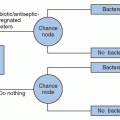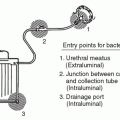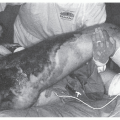Clinical Laboratory—Acquired Infections
Michael L. Wilson
L. Barth Reller
Clinical laboratories are an area of special concern in hospital infection control. Laboratory workers may be exposed to infectious agents during all steps of collection, transport, processing, and analysis of patients’ specimens. The clinical microbiology staff, in particular, is at risk of occupational infection, since the clinical specimens submitted for cultures are likely to contain infectious agents and the process of isolation and culture generates large numbers of pathogenic microorganisms.
The goals of this chapter are to provide an overview of the epidemiology of laboratory-acquired infections, to highlight those infections of special concern to laboratories, and to make specific recommendations for the prevention and control of laboratory-acquired infections. Not discussed in this chapter are the individual problems of clinical virology, research, anatomic pathology, commercial reference laboratories, and laboratories involved in the production or processing of large volumes of pathogenic microorganisms. The reader is referred to Collins’ monograph for an extensive review of the subject of laboratory-acquired infections (1). The roles of the clinical microbiology laboratory in infection surveillance, investigation of endemic and epidemic hospital infections, and the control of healthcare-associated infections (HAIs) are discussed in Chapters 5, 6, and 9, respectively.
INCIDENCE, CAUSATIVE AGENTS, AND COST
The true incidence of laboratory-acquired infections remains unknown. Early data were derived from surveys, personal communications, and literature reports, information that cannot be used to calculate incidence rates (2,3,4,5). More recent data are derived from surveys, which again cannot be used to calculate true incidence rates. One survey (6) did report an annual incidence of three laboratory-acquired infections per 1,000 employees, and another (7) reported annual incidences of 1.4 and 3.5 per 1,000 employees among workers in hospital-based and public health laboratories, respectively. A survey from United Kingdom laboratories during 1994 to 1995 reported an incidence rate of 16.2 infections per 100,000 person-years, compared with a rate of 82.7 infections per 100,000 person-years during 1988 to 1989 (8). Despite the limitations of the published data, it seems reasonable that the annual incidence of laboratory-acquired infections is between 1 and 5 per 1,000 employees. Another survey, from the United States, notes that up to 1/3 of clinical laboratories reported at least one laboratory-acquired infection during a 3-year period (9). This survey also noted the relative risk of infection compared with the general population, highlighting that working in a clinical microbiology laboratory poses a markedly increased relative risk of acquiring specific infections (9,10).
Determining the infectious agents that are the most common cause of laboratory-acquired infections is confounded by several factors. First, although infections with most of these agents are reportable to public health authorities, by their nature it may not be apparent where the infection was acquired. Second, some of the agents, such as Salmonella and Escherichia coli O157 are fairly common infections; because of this, infection in a laboratory worker could be assumed to be acquired in the community or during an outbreak. Last, infection with agents such as Mycobacterium tuberculosis may not result in clinical infection at the time and the exposure and thus may go undetected.
Historically, the most common laboratory-acquired infections were brucellosis, Q fever, typhoid fever, hepatitis B, and tuberculosis (3,4). More recent data show that the infections now most commonly acquired in clinical laboratories are caused by Shigella, Brucella, Salmonella, Staphylococcus aureus, Neisseria meningitidis, and E. coli O157 (9,10,11,12,13,14,15,16,17,18,19,20,21,22,23,24,25,26).
The costs to healthcare systems that result from laboratory-acquired infections are unknown. In one report (7), each laboratory-acquired infection resulted in an average of 1.2 lost work days for hospital-based laboratories and 1.3 lost work days for public health laboratories. In addition to lost productivity, however, there are the costs of diagnosis, treatment, and screening of coworkers. Institutions also bear the costs of investigations and reporting to regulatory and public health agencies. Accurate estimates of the cost to healthcare systems are not possible without additional data or further studies. The cost to infected individuals can be high; many laboratory-acquired infections are caused by pathogens capable of causing serious and/or chronic diseases. Fatal laboratory-acquired infections do continue to be reported (27). Although the incidence of serious or fatal infections is low compared with other societal risks, these infections can be readily prevented or, when they occur, most of them can be treated effectively. The goal should be to decrease the incidence and attributable morbidity and mortality of these infections to zero.
SOURCES OF INFECTIONS
Pike (2,3) and others (6,7,28,29) have attempted to determine which laboratory procedures, accidents, or other exposures to infectious agents are the source of laboratory-acquired infections (Table 22.1). These data indicate that the source of
infection is unknown in ≤20% of cases and that the infected individual is known only to have worked with the agents in the past in another 21% of cases (3). Thus, the exact source, procedure, or breach in technique can be identified in just over half of cases. Among the recognized sources are accidents, which account for 18% of cases. The kinds of accidents that lead to laboratory-acquired infections are listed in Table 22.2.
infection is unknown in ≤20% of cases and that the infected individual is known only to have worked with the agents in the past in another 21% of cases (3). Thus, the exact source, procedure, or breach in technique can be identified in just over half of cases. Among the recognized sources are accidents, which account for 18% of cases. The kinds of accidents that lead to laboratory-acquired infections are listed in Table 22.2.
TABLE 22.1 Sources of Laboratory-Acquired Infections in the United States and Abroad | ||||||||||||||||||||||||||||||||||||
|---|---|---|---|---|---|---|---|---|---|---|---|---|---|---|---|---|---|---|---|---|---|---|---|---|---|---|---|---|---|---|---|---|---|---|---|---|
| ||||||||||||||||||||||||||||||||||||
Laboratory accidents associated with exposure to infectious materials include creation of aerosols from spatters or spills; exposure of skin defects (i.e., cuts, abrasions, ulcers, dermatitis, and so on), conjunctivas, or mucosal surfaces; accidental aspiration or ingestions; and traumatic implantation (3). Needle-stick injuries and cuts with broken glass and other sharp objects account for up to half of accidents associated with laboratory-acquired infections (30,31). The microbiologic hazards associated with injuries from needle sticks and sharp objects have recently been reviewed (30,31). All laboratories should prohibit the use of needles and sharp instruments to the extent possible, as well as provide the necessary procedures and training for handling or use of “sharps” (32,33,34).
Aerosol droplets vary in size, with larger droplets rapidly settling onto exposed surfaces. These droplets may carry infectious agents and can thus contaminate environmental surfaces. Smaller droplets remain suspended in the air for a longer period of time and, under the appropriate environmental conditions, can remain suspended indefinitely. Aerosols with droplets measuring <5 mm in diameter can be inhaled directly into alveoli; those measuring ˜1 mm are the most likely to be retained within alveoli (35). Many common laboratory procedures have been shown to produce aerosols in this size range (36,37,38,39). Both M. tuberculosis and nontuberculous Mycobacteria associated with pulmonary infections may be transmitted by aerosols (40).
TABLE 22.2 Kinds of Laboratory Accident Resulting in Infection | |||||||||||||||||||||||||||
|---|---|---|---|---|---|---|---|---|---|---|---|---|---|---|---|---|---|---|---|---|---|---|---|---|---|---|---|
| |||||||||||||||||||||||||||
Laboratory personnel have among the highest rates of needle-stick injuries in healthcare workers (31,41). Most needle-stick injuries occur during disposal of used needles, assembly or disassembly of intravenous infusion sets, administration of parenteral injections or infusion therapy, drawing of blood, recapping of needles, or handling of waste that contains needles (31,41,42,43). Recapping needles is particularly hazardous, causing 12% to 30% of needle-stick injuries (31,41). It should be noted, however, that not recapping needles may also be hazardous (44). The epidemiology of needle-stick injuries among laboratory personnel has not been studied, but since activities such as intravenous infusion and handling infusion sets are not carried out in laboratories, recapping needles and handling waste are likely to be the most common causes of needle-stick injuries among laboratory personnel.
INFECTIOUS AGENTS OF SPECIAL CONCERN IN CLINICAL LABORATORIES
The risk of acquiring infections in a clinical laboratory is dependent upon several factors, the most important of which is the likelihood of exposure to an infectious agent (45). The probability that such an exposure will result in infection is dependent upon inoculum size, viability of the infectious agent, the immune status of the exposed individual, and the availability of effective postexposure prophylactic therapy.
PATHOGENIC BACTERIA
Bacterial infections of special concern to laboratory personnel are primarily those caused by highly virulent pathogens, such as Brucella, N. meningitidis, and Francisella tularensis (3,5,12,13,14,15,16,24,25,26) and the enteric pathogens Shigella, Salmonella, and E. coli O157:H7 (5,17,18,19




Stay updated, free articles. Join our Telegram channel

Full access? Get Clinical Tree







